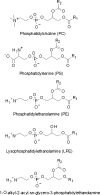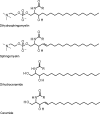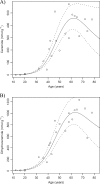Instability of the cellular lipidome with age
- PMID: 21894448
- PMCID: PMC3682067
- DOI: 10.1007/s11357-011-9293-6
Instability of the cellular lipidome with age
Abstract
The human lens nucleus is formed in utero, and from birth onwards, there appears to be no significant turnover of intracellular proteins or membrane components. Since, in adults, this region also lacks active enzymes, it offers the opportunity to examine the intrinsic stability of macromolecules under physiological conditions. Fifty seven human lenses, ranging in age from 12 to 82 years, were dissected into nucleus and cortex, and the nuclear lipids analyzed by electrospray ionization tandem mass spectrometry. In the first four decades of life, glycerophospholipids (with the exception of lysophosphatidylethanolamines) declined rapidly, such that by age 40, their content became negligible. In contrast the level of ceramides and dihydroceramides, which were undetectable prior to age 30, increased approximately 100-fold. The concentration of sphingomyelins and dihydrosphingomyelins remained unchanged over the whole life span. As a consequence of this marked alteration in composition, the properties of fiber cell membranes in the centre of young lenses are likely to be very different from those in older lenses. Interestingly, the identification of age 40 years as a time of transition in the lipid composition of the nucleus coincides with previously reported macroscopic changes in lens properties (e.g., a massive age-related increase in lens stiffness) and related pathologies such as presbyopia. The underlying reasons for the dramatic change in the lipid profile of the human lens with age are not known, but are most likely linked to the stability of some membrane lipids in a physiological environment.
Figures









Similar articles
-
Lipid domains in intact fiber-cell plasma membranes isolated from cortical and nuclear regions of human eye lenses of donors from different age groups.Exp Eye Res. 2015 Mar;132:78-90. doi: 10.1016/j.exer.2015.01.018. Epub 2015 Jan 21. Exp Eye Res. 2015. PMID: 25617680 Free PMC article.
-
Membrane association of proteins in the aging human lens: profound changes take place in the fifth decade of life.Invest Ophthalmol Vis Sci. 2009 Oct;50(10):4786-93. doi: 10.1167/iovs.09-3588. Epub 2009 May 20. Invest Ophthalmol Vis Sci. 2009. PMID: 19458333
-
Massive increase in the stiffness of the human lens nucleus with age: the basis for presbyopia?Mol Vis. 2004 Dec 16;10:956-63. Mol Vis. 2004. PMID: 15616482
-
Age-related nuclear cataract-oxidation is the key.Exp Eye Res. 2005 May;80(5):709-25. doi: 10.1016/j.exer.2004.12.007. Exp Eye Res. 2005. PMID: 15862178 Review.
-
Presbyopia: the first stage of nuclear cataract?Ophthalmic Res. 2006;38(3):137-48. doi: 10.1159/000090645. Epub 2006 Jan 3. Ophthalmic Res. 2006. PMID: 16397406 Review.
Cited by
-
Lens Aquaporins in Health and Disease: Location is Everything!Front Physiol. 2022 Apr 19;13:882550. doi: 10.3389/fphys.2022.882550. eCollection 2022. Front Physiol. 2022. PMID: 35514349 Free PMC article. Review.
-
Proteomic Analysis of Lipid Raft-Like Detergent-Resistant Membranes of Lens Fiber Cells.Invest Ophthalmol Vis Sci. 2015 Dec;56(13):8349-60. doi: 10.1167/iovs.15-18273. Invest Ophthalmol Vis Sci. 2015. PMID: 26747763 Free PMC article.
-
Deficiency in glutathione peroxidase 4 (GPX4) results in abnormal lens development and newborn cataract.Proc Natl Acad Sci U S A. 2024 Nov 26;121(48):e2407842121. doi: 10.1073/pnas.2407842121. Epub 2024 Nov 19. Proc Natl Acad Sci U S A. 2024. PMID: 39560644 Free PMC article.
-
Identification and quantification of ionising radiation-induced oxysterol formation in membranes of lens fibre cells.Adv Redox Res. 2023 Apr;7:None. doi: 10.1016/j.arres.2022.100057. Adv Redox Res. 2023. PMID: 38798747 Free PMC article.
-
Whales, lifespan, phospholipids, and cataracts.J Lipid Res. 2017 Dec;58(12):2289-2298. doi: 10.1194/jlr.M079368. Epub 2017 Oct 16. J Lipid Res. 2017. PMID: 29038122 Free PMC article.
References
Publication types
MeSH terms
Substances
LinkOut - more resources
Full Text Sources
Medical
Research Materials
